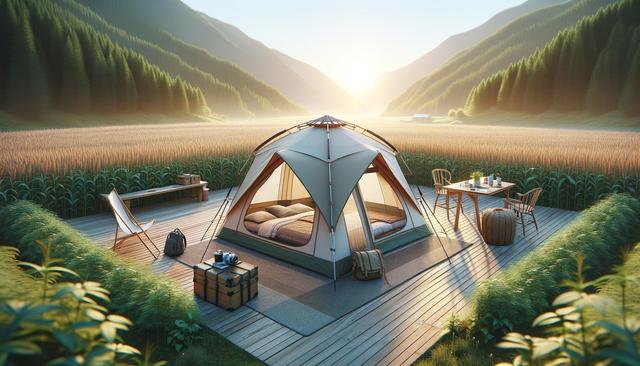Understanding Tent Categories: From Leisure to Expedition
Outdoor tents come in a range of types tailored to various activities and environments. For casual campers and weekend adventurers, three-season tents are a popular option. These models are generally lightweight, easy to set up, and designed to handle moderate weather conditions. For more demanding conditions, four-season tents offer enhanced protection against wind, snow, and colder temperatures. They typically feature stronger poles, steeper walls for snow shedding, and more robust fabrics. Meanwhile, mountaineering tents are engineered for high-altitude expeditions, prioritizing durability and weather resistance. Their compact footprint and aerodynamic shapes help withstand extreme conditions. Family tents and basecamp models offer generous interior space and multiple rooms, making them suitable for group camping or longer stays. Each category serves a specific purpose, so understanding your intended use is essential before making a decision.
Key Selection Criteria: What to Look for in a Tent
Choosing the right tent involves evaluating several critical features. The first consideration should be capacity—ensure the tent comfortably accommodates the number of occupants and their gear. Tent weight is also important, particularly for backpacking or hiking. Look for models that balance durability with portability. Weather resistance is another essential factor. Waterproof ratings, seam sealing, and ventilation systems all contribute to how well a tent performs in various climates. Ventilation, often enhanced with mesh panels and multiple vents, helps reduce interior condensation. Pole structure and material also affect stability and ease of setup. Common materials include aluminum for strength and fiberglass for affordability. Additional features to consider include:
- Vestibules for gear storage
- Interior pockets for organization
- Color-coded poles for easy setup
- UV-resistant coatings for sun protection
By comparing these elements, outdoor enthusiasts can select a tent that aligns with their adventure goals and environmental needs.
Materials and Construction: The Backbone of Tent Performance
The materials used in tent construction play a major role in performance and longevity. Tent fabrics are typically made from nylon or polyester, each offering advantages. Nylon is lightweight and strong, making it a preferred choice for backpacking tents. However, it tends to absorb water unless treated. Polyester, while slightly heavier, resists UV degradation and retains its shape better when wet. The denier rating of the fabric indicates its thickness and durability. For waterproofing, tents are often coated with polyurethane (PU) or silicone, and many include seam taping for added protection. The tent floor requires extra reinforcement, often with higher-denier material and bathtub-style construction to prevent water intrusion. Poles are another crucial component—aluminum poles offer strength and flexibility, while composite materials may reduce cost but can be more prone to breakage. Zippers, guy lines, and stake quality also contribute to overall reliability. Understanding these construction details helps users assess how well a tent will hold up in real-world conditions.
Setting Up and Using Your Tent Effectively
Proper setup is essential for maximizing a tent’s function and lifespan. Before heading into the wilderness, practice pitching the tent at home to become familiar with the assembly process. Look for a flat, elevated site that avoids low areas where water can collect. Clear the ground of debris to protect the tent floor. When staking out the tent, use all available guy lines and anchors to ensure stability, especially in windy conditions. Rainflys should be tensioned properly to prevent sagging and water pooling. For added comfort, consider using a footprint or groundsheet beneath the tent to prevent wear and moisture from seeping in. During use, ventilation is key—open vents and doors when possible to reduce condensation buildup. Always store food and scented items outside the tent to minimize wildlife encounters. After each trip, clean the tent with lukewarm water and a soft sponge, avoiding harsh detergents. Let it air dry completely before storing in a cool, dry place.
Maintaining and Storing Your Tent for Longevity
Taking care of your outdoor tent ensures it remains reliable for years to come. After each use, inspect all components for damage—check for bent poles, torn mesh, or worn zippers. Address minor issues promptly to prevent them from worsening. Avoid prolonged exposure to direct sunlight, which can degrade fabric materials. When cleaning, use mild soap only when necessary, and never machine wash or dry the tent. Store the tent loosely in a breathable bag rather than compressed in its stuff sack to preserve fabric elasticity and prevent mildew. Periodically seam seal the tent if the original waterproof coating begins to wear off. Re-coating the rainfly and floor with appropriate waterproofing treatments can extend their protective qualities. If any parts are damaged beyond repair, many manufacturers offer replacement poles, zippers, or fabric patches. By incorporating these maintenance habits, campers can ensure their tent continues to perform well across multiple seasons and adventures.
Conclusion: Choosing the Right Tent for Your Adventures
Whether you’re new to camping or an experienced mountaineer, selecting the right outdoor tent is a foundational step toward a safe and enjoyable journey. By understanding the various types of tents and evaluating key features such as capacity, weight, and material quality, adventurers can make informed decisions that align with their specific needs. Proper setup, use, and maintenance further enhance the tent’s performance and longevity. With thoughtful planning and care, your tent can serve as a reliable shelter in the wild, contributing to memorable and comfortable outdoor experiences.








